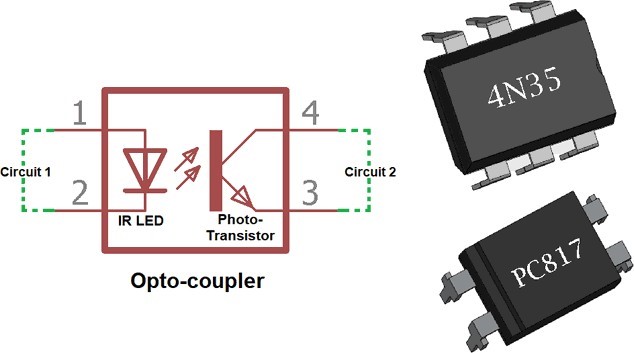Optocoupler
An optocoupler, also known as an opto-isolator, is an electronic component used to transfer electrical signals between two isolated circuits through optical means, providing electrical isolation while allowing signal transmission. It typically consists of an LED (Light Emitting Diode) and a photodetector, such as a photodiode, phototransistor, or photoSCR, which are optically coupled but electrically isolated from each other. The LED is used to emit light when an electrical current passes through it, and the photodetector receives this light and converts it back into an electrical signal on the other side. This optical isolation prevents high voltages or electrical noise from transferring between the circuits, which helps protect sensitive components or systems from damage.
Optocouplers are widely used in applications where it is necessary to isolate different sections of a circuit that operate at different voltage levels, such as in switching power supplies, communication systems, motor control, and microcontroller interfacing. They are particularly important in environments with high-voltage equipment or noisy electrical conditions, as they help prevent spikes or surges from propagating through the circuit and damaging sensitive components.
The key advantage of using an optocoupler is electrical isolation. This isolation protects delicate circuits from voltage spikes, electromagnetic interference (EMI), and ground loops, ensuring that high voltage and low voltage parts of a system remain electrically separated. This is crucial in systems where a low-voltage microcontroller or logic circuit needs to interface with high-voltage components, such as power transistors or relays, without risking damage to the low-voltage side.
The components inside an optocoupler are typically housed in a small package that enables easy integration into various systems. The most common types of optocouplers include the phototransistor optocoupler, which offers high speed and is used in high-frequency applications, and the photodiode optocoupler, which is simpler and used for low-speed, low-frequency applications. Some optocouplers feature additional components, like photometric relays, to handle more complex switching tasks.
Overall, optocouplers are invaluable in modern electronic systems, offering a combination of safety, efficiency, and signal integrity. By isolating circuits and controlling signal transmission optically, they protect both the electronics and users, enabling the reliable operation of a wide range of devices, from industrial machinery to consumer electronics.
Optocouplers are widely used in applications where it is necessary to isolate different sections of a circuit that operate at different voltage levels, such as in switching power supplies, communication systems, motor control, and microcontroller interfacing. They are particularly important in environments with high-voltage equipment or noisy electrical conditions, as they help prevent spikes or surges from propagating through the circuit and damaging sensitive components.
The key advantage of using an optocoupler is electrical isolation. This isolation protects delicate circuits from voltage spikes, electromagnetic interference (EMI), and ground loops, ensuring that high voltage and low voltage parts of a system remain electrically separated. This is crucial in systems where a low-voltage microcontroller or logic circuit needs to interface with high-voltage components, such as power transistors or relays, without risking damage to the low-voltage side.
The components inside an optocoupler are typically housed in a small package that enables easy integration into various systems. The most common types of optocouplers include the phototransistor optocoupler, which offers high speed and is used in high-frequency applications, and the photodiode optocoupler, which is simpler and used for low-speed, low-frequency applications. Some optocouplers feature additional components, like photometric relays, to handle more complex switching tasks.
Overall, optocouplers are invaluable in modern electronic systems, offering a combination of safety, efficiency, and signal integrity. By isolating circuits and controlling signal transmission optically, they protect both the electronics and users, enabling the reliable operation of a wide range of devices, from industrial machinery to consumer electronics.
